Description of varieties of yellow peonies, care and planting

Peonies with yellow flowers appeared much later than their counterparts in other colors. Breeders around the world have been trying to develop such varieties for a long time. Since the 30s of the last century, there have been many attempts, but it was not possible to obtain a persistent color, and the petals turned white under the influence of sunlight.
For the first time, plants with yellow buds that do not fade in the sun were obtained in the 50s by the Japanese scientist Toichi Ito by crossing two types of peonies - tree and herbaceous. From this time on, the parade procession of sunny flowers all over the world begins.
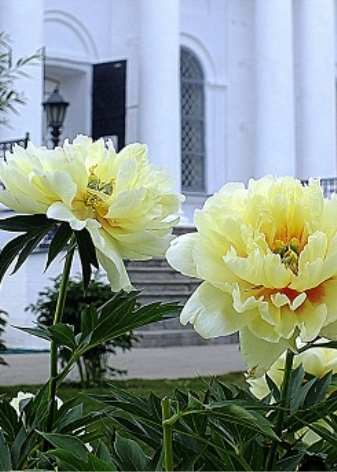
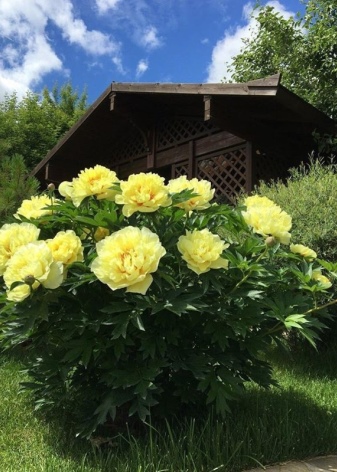
Description
Due to interspecific hybridization, yellow peonies differ slightly from ordinary herbaceous ones. It is possible to separate the rhizome for transplantation and reproduction until about three to four years of age. Later, it hardens so much that it is not cut by anything other than a saw. But if there is no goal to increase the collection, this is not an obstacle to breeding such a beautiful plant on your site. Indeed, with the right location, the peony will delight with flowering for a very long time.
Yellow peonies can grow up to 90 centimeters in height. Some specimens reach 1 meter. Leaves and stems are dark green in color. The aboveground part dies off for the winter, like in herbaceous varieties. Flowers are semi-double and double, large, about 17-20 centimeters in diameter.
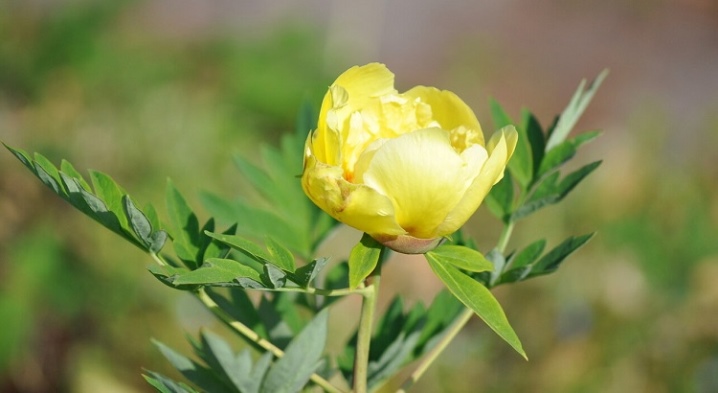
The best varieties
Currently, a large assortment of yellow peonies is presented in various catalogs. The color can be from pale lemon to almost bright sunny.
Below is a description of the best representatives of this family:
- "Yellow Crown" - a flower of American selection. This variety belongs to undersized, its height is no more than 60 centimeters. The flowers are large, double and semi-double, bright yellow, with reddish spots in the middle, fragrant. The flowering period is average. It is better to plant immediately to a permanent place, since during transplantation it is sick and does not take root well.
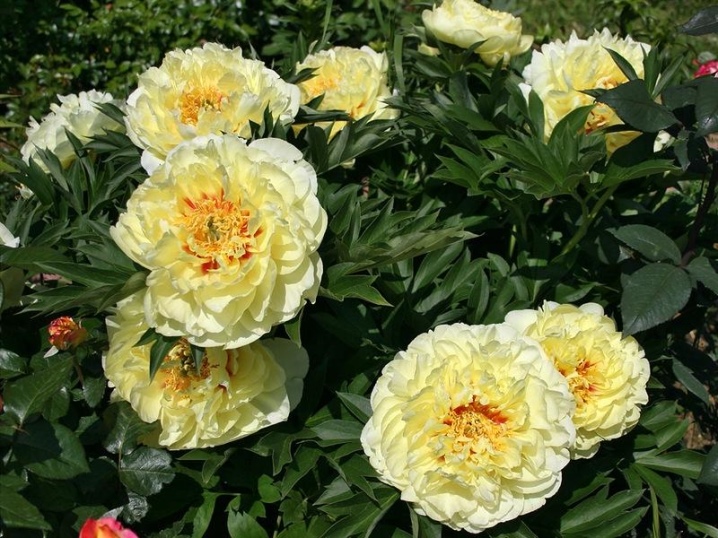
- Roy Person's Best Yellow - also introduced to the USA. The plant grows up to 80 centimeters. The flower shape is simple, the size is average. The petals are light, almost white, with a slight yellowish tinge. In the center are yellow stamens. Blooms in the middle of summer.
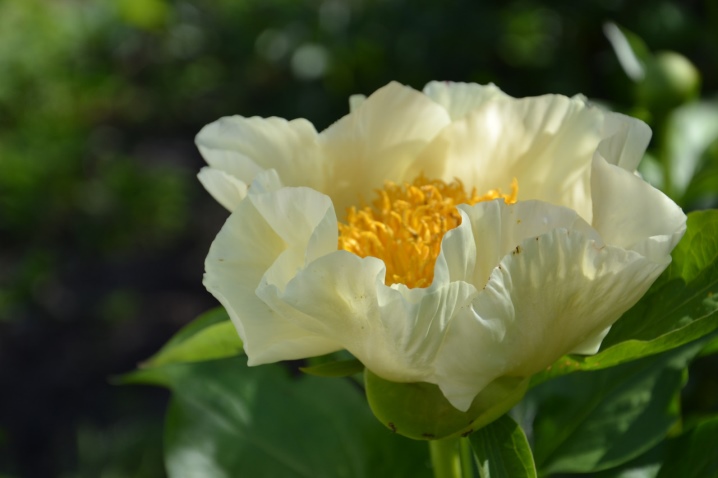
- Yellow King. Country of origin - USA. Tall, about 80-85 centimeters, with strong stems. The flowers are simple, pinkish at the stage of buds, then white, with a lush yellow center, with a delicate aroma. Flowering in medium terms, abundant.
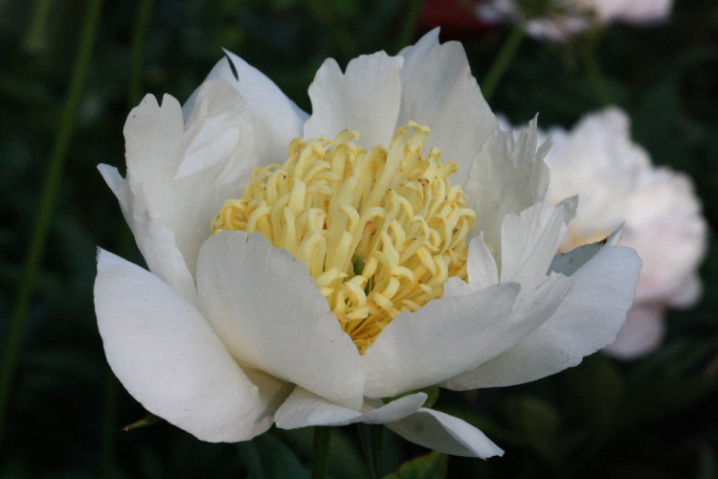
- "Yellow Waterly" Is a new variety created in the United States in 1999. A powerful, sturdy bush covered with large double flowers, reminiscent of water lilies. The color is light lemon, with small splashes of lavender tones around the stamens. Stretched flowering.
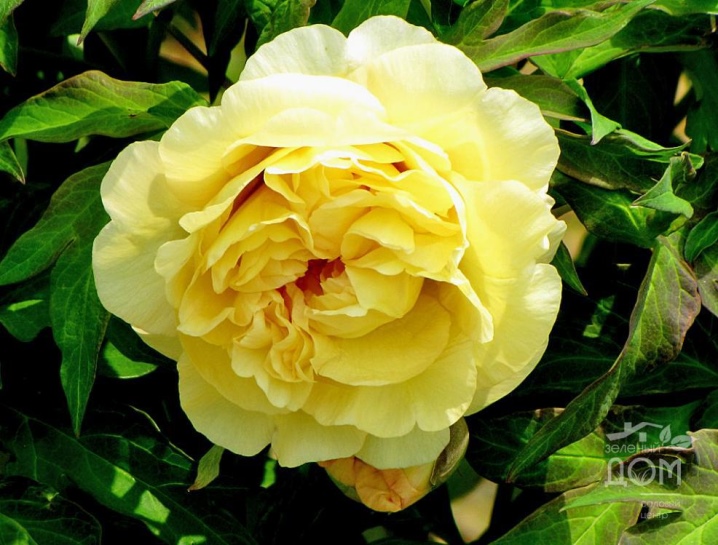
- Mock orange yellow - also originally from America. Bred relatively recently. Tall, grows up to 80 centimeters. A large number of semi-double large flowers of interesting color - yellow with pink, from a distance they seem orange.

- Lactiflora yellow -plant of medium size. The flowers are semi-double, milky white with a yellowish tinge.
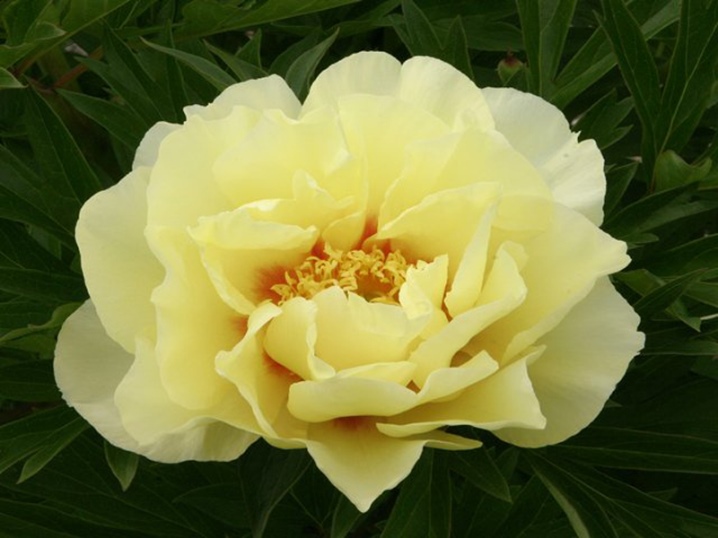
- "Laura dessert". The bush reaches 1 meter in height. The stems are strong. Long bloom, from May, for a month. The flower is lush, terry, white on the outside, and yellow-cream in the middle, similar to a vase of vanilla ice cream, very fragrant. The name justifies itself.
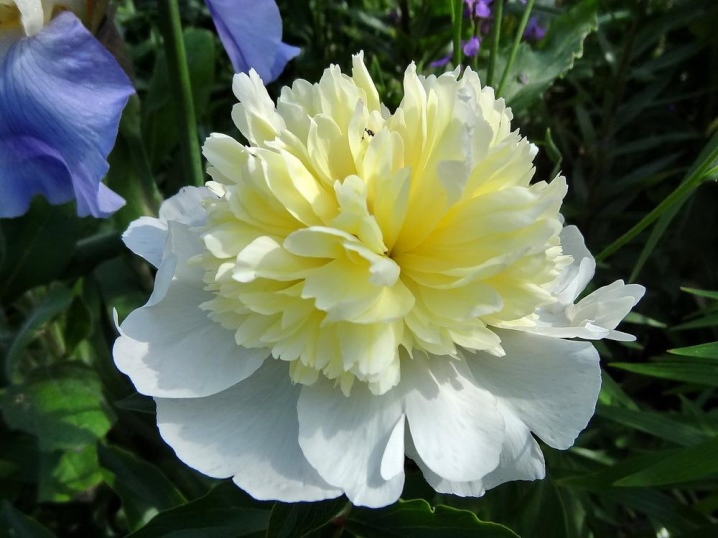
Landing features
Like all other types of peonies, yellow-flowered plants prefer an open, sunny place, protected from strong winds and drafts. They also do not like the close proximity of trees, shrubs and various buildings.
The planting hole should be large and deep enough (about 1 meter) to accommodate highly growing rhizomes. The distance between adult bushes is not less than 1-1.5 meters, taking this into account, the seedlings are located.
It should also be remembered that plants cannot stand waterlogging, excess water is more destructive for them than drought. Therefore, there should be no close occurrence of groundwater and the threat of spring flooding.


Peonies can be planted both in spring and autumn. Still, the most favorable time is considered to be the period from late August to mid-September. For normal growth and flowering, you need to provide the bushes with adequate nutrition. When planting, 2-3 buckets of humus or compost are poured into the pit, 500-700 grams of ash are added and about a glass of superphosphate or potassium sulfate. Everything is thoroughly mixed with soil. Then the seedling is placed in the center, covered with earth so that the upper buds are at a depth of no more than 4-5 centimeters.
It should be remembered that both with buried and too shallow planting, peonies will not bloom. The soil around the bush is slightly compacted, the plant is watered abundantly and the soil is mulched with sawdust or dry humus. A layer of mulch will help retain moisture, inhibit weed growth, and provide additional nutrition.
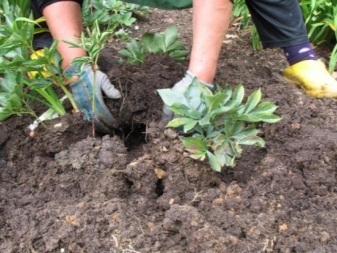
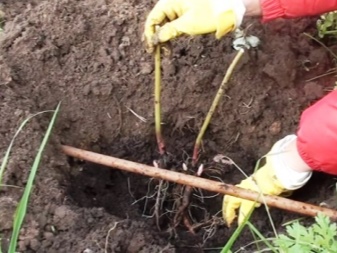
Care
In the first year after planting, plant care includes the following activities.
- Timely watering. Depends on the meteorological conditions in each specific year.
- Loosening the soil. It is carried out both after watering and after rain.
- Weeding - as needed. The use of mulching greatly reduces this work.
In late autumn, after frosts, the aboveground part is cut off at a height of about 10-15 centimeters above the soil level. Although peonies are quite frost-resistant species, it is better to cover young bushes for the winter (especially in regions with a cold climate). In the second or third year, when flowering begins, fertilizing is carried out with fertilizers, which contain phosphorus and potassium.
It is better to combine this procedure with watering. The optimal time is the beginning of bud blooming.
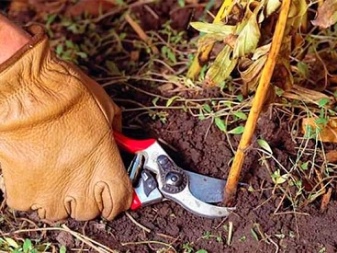
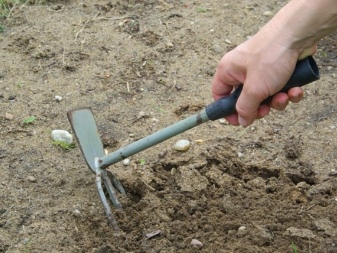
Reproduction
When propagating this species, one should take into account their feature - lignification of the rhizome. The older the plant gets, the more difficult it will be to divide it into several parts. But if such a need has already arisen, you need to act carefully so as not to destroy the peony.
The optimal timing for division and reproduction of peonies is the same as for planting. But, according to the observations of experienced gardeners, an early spring transplant is still preferable, when the first shoots just begin to appear from the ground. The plant divided at this time will have time to recover, get stronger and prepare for wintering during the warm period.
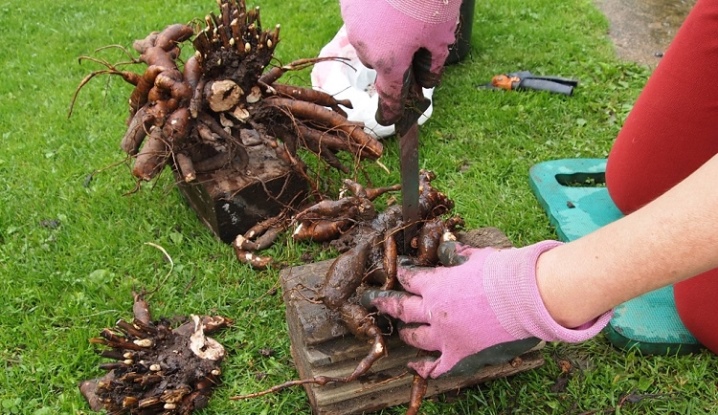
The order of work is as follows:
- the soil around the bush is first dug in a circle, gradually deepening into the ground;
- using a shovel or crowbar, the rhizomes are carefully lifted and pulled out;
- cleaned from the ground, carefully so as not to break off the sprouts;
- examine and determine in what place it will be better and more convenient to divide the roots;
- cut, leaving at least 3 buds on each part;
- then they dig holes according to the number of the resulting parts;
- add humus and fertilizers (as in a normal planting), mix with the soil;
- set the divide in the pit and cover it with earth so that the upper kidney is no deeper than 4 centimeters;
- watered, mulched.
Further care is no different from the usual, as when planting seedlings.
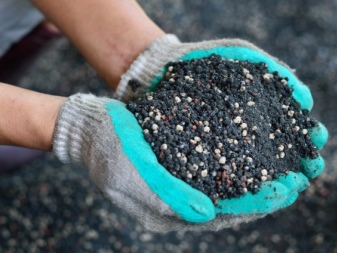
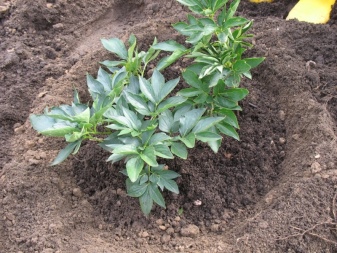
Examples in landscape design
Luxurious bushes of flowering peonies will decorate any site. A variety of colors and shapes of inflorescences allow you to create landscape design projects for every taste.
The main factors to consider when planning a flower bed with peonies:
- these are long-lived plants, therefore, in one place without transplanting, they can grow for 10-15 years, and tree varieties even longer;
- love sunny, open places, without wind and drafts;
- do not tolerate dampness and close occurrence of groundwater;
- there should be no tall trees, bushes, buildings nearby;
- the first 3-4 years gain strength, grow and only then begin to bloom;
- an adult bush takes up a lot of space both in height and in width;
- under the weight of a large number of large flowers, the shoots are inclined to the very ground, so the plants will need support.
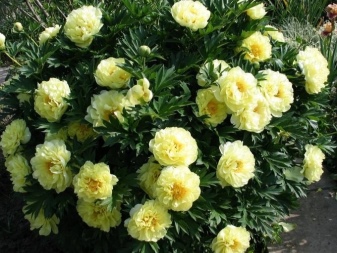
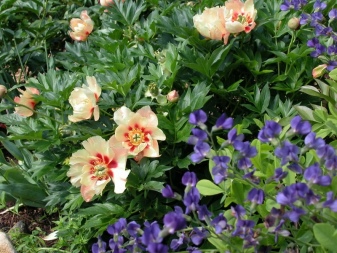
To fully reveal the splendor of peonies in landscape design, there are several basic options for their placement.
- In a large space you can sow a lawn and place one or more bushes on it, as an option - equip a long-tiered, stepped flower garden.
- Combine planting peonies with hybrid tea roses. They bloom at different times, which means they will replace and complement each other.
- In the center of a round flower bed plant one peony, and along the edges add the composition with low-growing flowers or ground cover plants. For example, such as incense, sage, poppies, bells or early flowering bulbs.
- Decorate a garden path with a border from several peonies planted in a row, and around them - any perennials or annuals. If you plant a different flower every season, your garden design will change. In this case, it is necessary to provide some kind of support in advance so that the flowers do not interfere with walking.
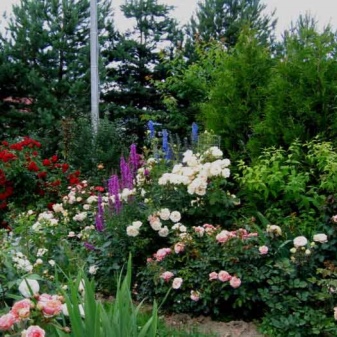
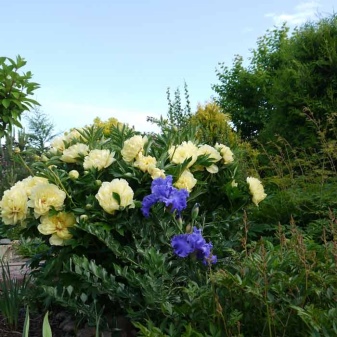
"Neighbors" for peonies are selected taking into account that their needs for illumination, humidity and other parameters coincide. From a wide variety, you can offer the following plants:
- roses;
- tulips;
- lilies;
- day-lily;
- godetia;
- phlox;
- astilba;
- chrysanthemums;
- asters;
- zinnias;
- nasturtium;
- petunia.
Tall gladioli, spirea, mallow, hydrangeas will also look good on the same flowerbed with peonies.
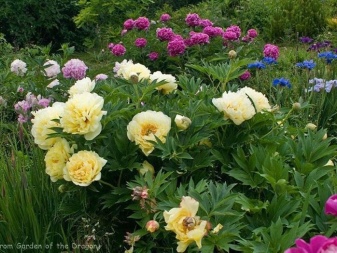
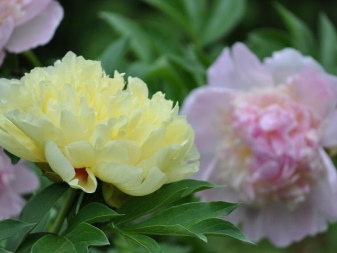
In any case, with good care, peonies will delight with their splendor for many years. This is the flower that you definitely need to plant in your garden.
In the next video, you can take a look at the yellow peonies of the Bartzella variety.







































































































The comment was sent successfully.